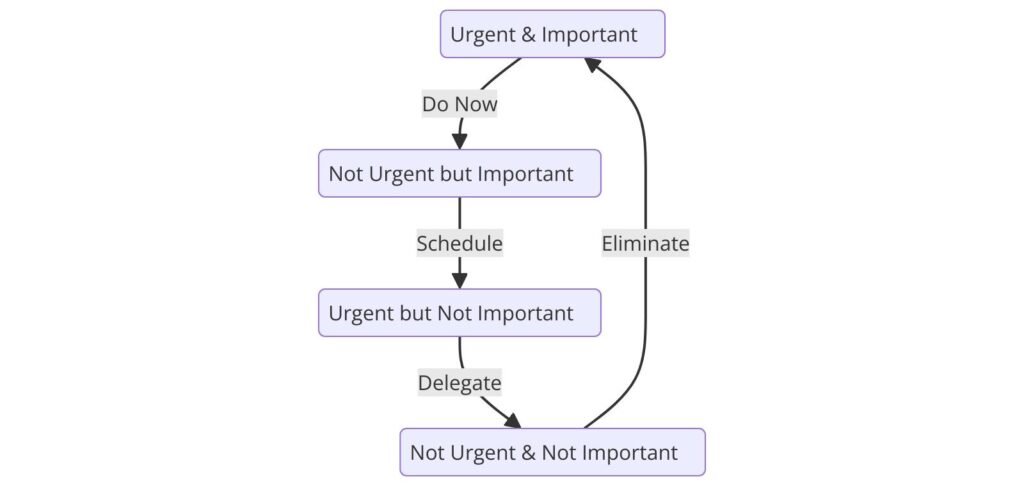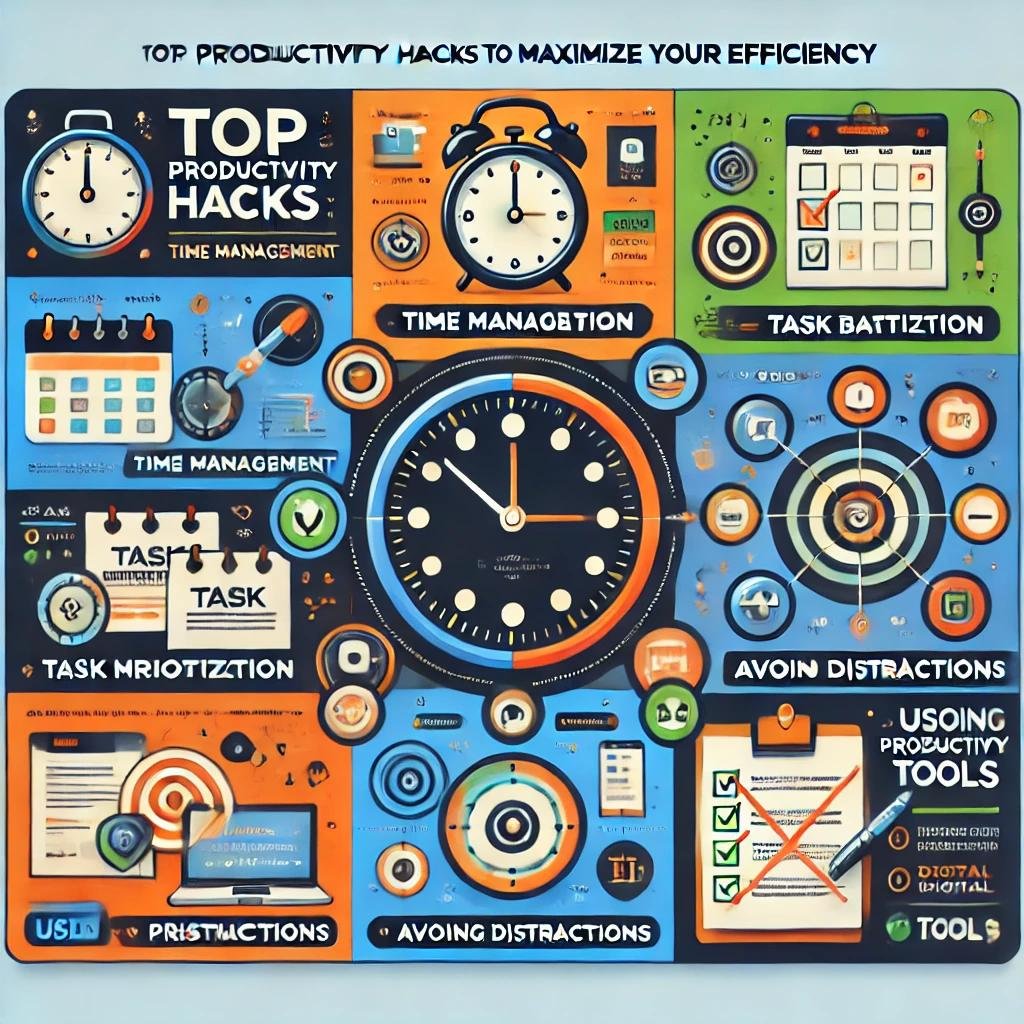We are living in a fast-paced world, staying on top of tasks and managing time effectively is crucial for success. With the right productivity hacks, you can optimize your workflow, reduce distractions, and get more done in less time. In this article, we’ll explore seven powerful productivity hacks, real-life examples, and tools you can use right away.
1. Time Blocking for Focused Work
Time blocking is an effective technique to allocate specific hours of the day to tasks, minimizing distractions and maintaining focus. This method involves scheduling dedicated “blocks” of time for tasks instead of juggling multiple activities at once.
Real-Life Example:
Elon Musk is known to use time blocking to manage his various companies. He splits his day into 5-minute slots, ensuring that every minute counts. By doing this, he can focus intently on each task without overlap, achieving more in less time.
How to implement:
- Use Google Calendar to assign specific tasks to dedicated time slots.
- Avoid multitasking during these blocks; focus on one task at a time.

2. The Pomodoro Technique for Sustained Concentration
The Pomodoro Technique is a simple time-management hack where you work in focused intervals of 25 minutes, followed by a short break. This technique maximizes productivity by allowing periods of deep focus while preventing burnout.
Real-Life Example:
Maria, a software developer, increased her coding output by 20% after adopting the Pomodoro Technique. By working in short sprints, she avoided fatigue and stayed energized throughout the day.
How to implement:
- Start a timer for 25 minutes and focus on a task during that time.
- After 25 minutes, take a 5-minute break.
- After completing 4 Pomodoro sessions, take an extended break lasting between 15 to 30 minutes..
Personal opinion :To increase productivity, I have used the Pomodoro Technique in my work. However, instead of taking a break after 25 minutes, I have taken a 5 to 10-minute break after working for 40-45 minutes. And I have achieved significant results. So, it’s not necessary to take a break right after 25 minutes; it doesn’t cause any issues if you don’t. However, taking a break within 25 to 45 minutes is still beneficial.
3. Automate Repetitive Tasks
Automation is one of the most powerful productivity hacks. It reduces the time spent on repetitive tasks, allowing you to focus on more valuable work. Tools like Zapier and IFTTT can automate processes such as sending emails, updating spreadsheets, or posting on social media.
Real-Life Example:
John, a small business owner, used Zapier to automatically send email invoices when clients filled out an order form. This saved him 3 hours per week on administrative tasks.
Tools to use:
- Zapier: Automate workflows by linking apps together.
- IFTTT: Create custom automation for personal and business tasks.
4. Apply the Two-Minute Rule to handle quick tasks efficiently.
The Two-Minute Rule, popularized by David Allen in Getting Things Done, is simple: if a task takes less than two minutes, do it immediately.This helps keep small tasks from accumulating and overwhelming your to-do list.
Real-Life Example:
Sarah, an executive assistant, noticed her emails piling up daily. By applying the Two-Minute Rule, she immediately responded to quick emails, keeping her inbox manageable.
How to implement:
- When a small task arises (e.g., replying to an email or filing a document), complete it on the spot if it takes less than two minutes.
- Set reminders to revisit longer tasks later in the day.
5. Prioritize with the Eisenhower Matrix
The Eisenhower Matrix assists in prioritizing tasks by considering both their urgency and importance.
- Urgent and important
- Important but not urgent
- Urgent but not important
- Not urgent and not important
Real-Life Example:
Annie, a marketing manager, used the Eisenhower Matrix to restructure her to-do list. She noticed that many tasks were urgent but not important, distracting her from bigger goals. By focusing on important tasks, she improved her team’s performance by 15%.

6. Batch Similar Tasks Together
Task batching is the practice of organizing similar tasks together and completing them in a single session.For example, instead of checking email 20 times a day, allocate two time slots to batch email responses.
Real-Life Example:
Ryan, a content creator, found that switching between tasks reduced his productivity. By batching similar activities (like replying to comments and emails), he saved 1 hour daily.
How to implement:
- Group tasks by type (e.g., email replies, social media posts, meetings).
- Allocate specific times of the day to handle these batches.
7. The Power of Decluttering for Mental Clarity
A cluttered workspace can distract you and reduce productivity. A clean, organized environment leads to better focus and efficiency.
Real-Life Example:
Steve Jobs was famous for keeping a minimalist desk. This simplicity helped him maintain focus on what mattered most—innovation. Research has shown that decluttering your workspace can boost productivity by up to 30%.
How to implement:
- Spend 10 minutes every evening cleaning up your workspace.
- Use storage solutions to keep essential tools at hand and distractions out of sight.
Bonus Hack: Use Project Management Tools
Keyword: Best productivity tools for teams
For team productivity, tools like Asana, Trello, and Slack help streamline communication and task management. These tools allow teams to collaborate, track progress, and keep deadlines in check.
Statistics:
- A study by Wrike found that companies using project management tools saw a 20% increase in productivity within the first three months
Conclusion: Boost Your Productivity Starting Today
Incorporating these productivity hacks can lead to transformative changes in your daily routine. Whether you choose to automate repetitive tasks, implement the Pomodoro Technique, or declutter your workspace, every small change can have a big impact on your overall efficiency.
Frequently Asked Questions (FAQs):
- How does time blocking improve productivity?
Time blocking helps by assigning specific periods to tasks, reducing multitasking, and promoting deep focus. - What is the Pomodoro Technique, and why is it effective?
The Pomodoro Technique breaks work into manageable intervals, allowing you to maintain focus without burning out. - Why is decluttering important for productivity?
A clean workspace reduces distractions and helps maintain mental clarity, boosting focus by up to 30%. - How do automation tools like Zapier increase efficiency?
Automation tools eliminate repetitive tasks, saving time and allowing you to focus on more critical work. - What is the Eisenhower Matrix?
The Eisenhower Matrix helps prioritize tasks based on their urgency and importance, ensuring you focus on the most impactful activities. - How does task batching work?
Task batching involves grouping similar tasks together and completing them at once, reducing the inefficiency caused by constant task-switching.


1 Comment
Pingback: Time Management Strategies is the Path to Success and Productivity - Dreambiggertoday